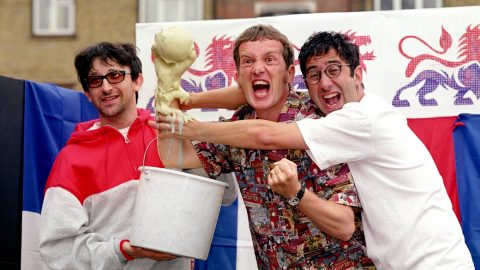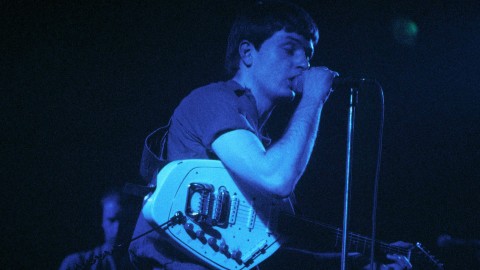
To mark the release of Last Night In Soho, Edgar Wright’s acclaimed new psychological thriller set in the heart of London’s sin city, we suggest what a music lover might like to do with One Day In Soho…
Ziggy’s alley, 22 Heddon Street
Tucked away from the posh shops on Regent Street, this is the unassuming alley that features on the cover of David Bowie’s ‘The Rise and Fall of Ziggy Stardust and the Spiders from Mars’. The picture was taken by photographer Brian Ward in 1972, and the location is now marked with a blue plaque.
The Toucan, 19 Carlisle Street
This tiny boozer – the best place to grab a Guinness in Soho – appears in Last Night In Soho as one of the film’s characters, Eloise, scores a job there. The pub was faithfully recreated on the soundstage at Ealing Studios especially for the purpose.
Epicentre of swinging London, Carnaby Street

Where Dedicated Followers Of Fashion went to kit themselves out in the 1960s. Carnaby and its surrounding area still retains a whiff of rock ‘n’ roll attitude, even if the street is now mostly for shops that want to relieve you of £600 for a pair of Chelsea boots. Head for the official Rolling Stones shop instead.
Former Trident Studios, 17 St Anne’s Court
Now a private workspace, this was the recording studio where David Bowie made ‘Hunky Dory’ and The Beatles recorded most of the so-called ‘White Album’, having worked almost exclusively at Abbey Road before that. If that ever comes up in a pub quiz, you owe us one.
MPL Music Publishing, 1 Soho Square
Stand in Soho Square. Look right. No, your right. That unassuming Soho office block is the hub of Paul McCartney’s operations. Look: Paul is at the window, looking at you, looking at him. Now you’re waving and he’s… calling the police?
Site of The Marquee, 90 Wardour Street

Great lost venue The Marquee is, sadly, long gone, but a blue plaque commemorating The Who drummer Keith Moon marks the site of a club that hosted an entire generation of British beat, psych and blues bands.
The 100 Club, 100 Oxford Street
The 100 Club lays legitimate claim to being the oldest dedicated music venue in the world, and its resilience speaks volumes about the special magic that happens in that sweaty basement. See the pavement outside? That once had Sid Vicious’s blood on it, probably.
The Ship, 116 Wardour Street
This classic Edwardian boozer was David Bowie’s favourite place to do interviews and was a preferred watering hole of The Who, the Stones and more. Still a cracking place to get a pint, its walls are plastered with great rock photography.
Site of Raymond’s Revuebar, 11 Walker’s Court

The Revuebar, opened in 1958 by adult entertainment kingpin Paul Raymond, was the first place randy Brits could see full nudity on stage. Its runaway success kickstarted a trend that shaped Soho’s transformation into the UK’s capital of smut. The bar – frequented by many a pop scenester – is long gone, but its saucy neon sign remains.
The Bag O’ Nails, 9 Kingly Street
An unassuming basement located on a quiet street, the Bag O’ Nails club was a favourite haunt of Beatles, Stones, Kinks and pretty much everyone whose name starts with The. It’s now a private members’ club, so you might have to content yourself with pressing your face up against the darkened windows like a Victorian street urchin at Christmas.
Jimi Hendrix’s flat, 25 Brook Street

Jimi Hendrix’s 1960s flat has been recreated in situ at Handel & Hendrix museum – even with period copies of NME and Melody Maker scattered around. Next door, you can also visit the 1723 flat of composer George Frideric Handel. As much as that combo is as bonkers as, say, sticky toffee fish pudding, it’s an odd-couple sitcom we’d very much like to watch.
Tin Pan Alley, Denmark Street
So-called Tin Pan Alley was the home of the British music industry in the 1960s, thanks to the labels, songwriters and studios which occupied its townhouses. And that’s not to mention the very first NME office – we opened on Denmark Street in 1952. Later home to musical instrument shops that were a honeypot for visiting artists, the street is now mostly made of train station. Thanks, Crossrail.
Ronnie Scott’s, 47 Frith Street

Still the place to catch jazz in central London. Ronnie Scott’s was founded in 1959 by Scott, a celebrated jazz saxophonist, and has since attracted pretty much every major player in the world of jazz, from Miles Davis to Amy Winehouse. The birth of cool? Yep, it happened here.
Last Night In Soho is in cinemas on Friday (October 29).
The post A music lover’s visitors guide to Soho, inspired by ‘Last Night In Soho’ appeared first on NME.



